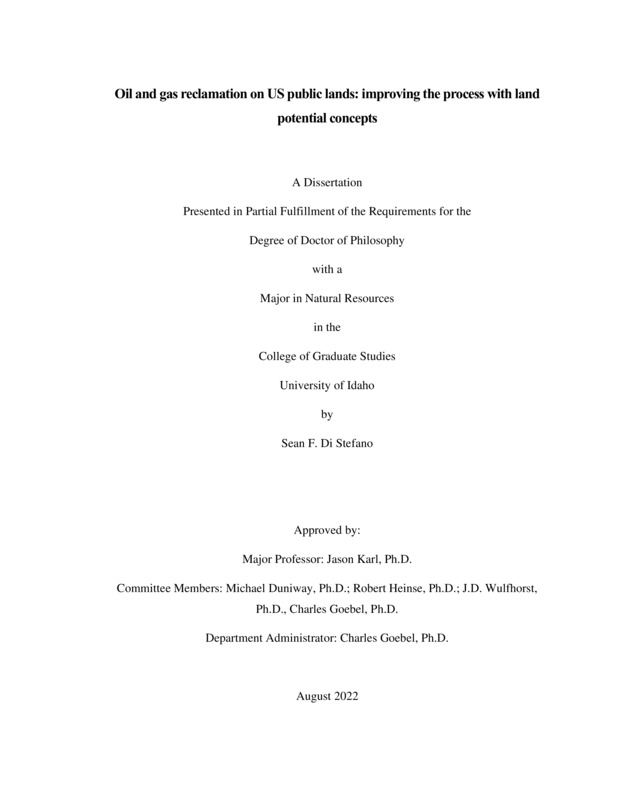Oil and gas reclamation on US public lands: improving the process with land potential concepts
Di Stefano, Sean. (2022-08). Oil and gas reclamation on US public lands: improving the process with land potential concepts. Theses and Dissertations Collection, University of Idaho Library Digital Collections. https://www.lib.uidaho.edu/digital/etd/items/distefano_idaho_0089e_12424.html
- Title:
- Oil and gas reclamation on US public lands: improving the process with land potential concepts
- Author:
- Di Stefano, Sean
- Date:
- 2022-08
- Keywords:
- land potential monitoring oil and gas reclamation
- Program:
- Forest, Rangeland & Fire Sci
- Subject Category:
- Range management; Natural resource management; Remote sensing
- Abstract:
-
There is an increasing worldwide concern for the current and long-term environmental impacts of oil and gas development such as severe habitat fragmentation, disruption of plant-water relationships, increased soil toxicity, and altered hydrology of landscapes. One of the primary areas of concern has been on public lands where the government is under a multiple use mandate to manage for all the ecosystem services a site has to offer. There are no standardized quantitative benchmarks or monitoring methods for measuring long-term oil and gas reclamation effectiveness on public lands in the U.S. The methods and standards that do exist vary widely by location, are usually qualitative, and are often subjective to an individual reclamation manager’s opinion. This situation makes it difficult for the private industry to meet reclamation goals over large landscapes and across multiple regulatory entitiesIn this dissertation, we evaluated the utility of using land potential in reclamation evaluations by 1) reviewing the current status of oil and gas reclamation on US public land 2) defining land potential in the context of oil and gas reclamation, 3) conducting a time series analysis of reclaimed well pads before and after development, and 4) analyzing field data for reclaimed well pads of different times since reclamation completion (i.e., reclamation age), based on plant and soil traits found to be sensitive to oil and gas development. In the time series analysis, differences in reclamation management had a high impact on reclamation outcomes making it difficult to discern typical plant community structural changes at different reclamation ages. On the ground, we found that differences between reclamation ages was greatest between 5 years and 15 years with 15 years appearing to experience the full effects of reclamation such as having a higher amount of native perennial grasses and decreased soil electrical conductivity. Additionally, we were able to evaluate for altered land potential based on a group of indicators not by an individual indicator. Overall, we recommend that a group of indicators should be evaluated with quantitative data, preferably with data collected more than once before the final reclamation evaluation, and that a standardized set of methods should be used to improve the consistency and transparency of reclamation evaluation on US public land. By doing so, communication and collaboration between the federal government and private industry may improve to help alleviate the widespread loss of ecosystem services to oil and gas development on US public lands.
- Description:
- doctoral, Ph.D., Forest, Rangeland & Fire Sci -- University of Idaho - College of Graduate Studies, 2022-08
- Major Professor:
- Karl, Jason
- Committee:
- Duniway, Michael; Heinse, Robert; Wulfhorst, J.D.; Goebel, Charles
- Defense Date:
- 2022-08
- Identifier:
- DiStefano_idaho_0089E_12424
- Type:
- Text
- Format Original:
- Format:
- application/pdf
- Rights:
- In Copyright - Educational Use Permitted. For more information, please contact University of Idaho Library Special Collections and Archives Department at libspec@uidaho.edu.
- Standardized Rights:
- http://rightsstatements.org/vocab/InC-EDU/1.0/

